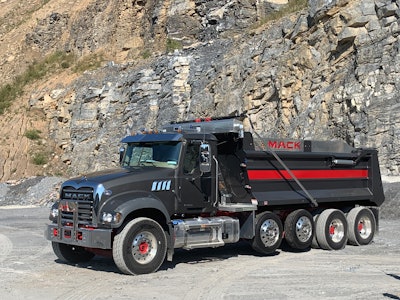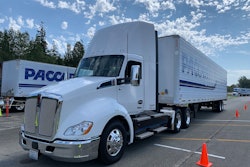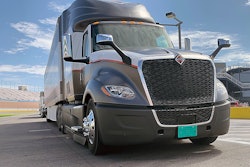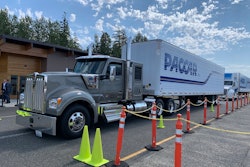
The fully electric truck may feel like it's a couple battery iterations away from mass production, but the electrification of existing parts of a conventional driveline is the technology of today. Granted, the goals here are markedly different. One is a planet-saving zero-emission vehicle, the other – in this case Mack Trucks' Command Steer – takes aim at driver comfort and safety.
Command Steer, an electrically-assisted hydraulic steering system, has been available on certain Mack Models since 2020. It adds an electric motor to the existing hydraulic steering system to reduce manual steering input from the driver by up to 85%, and reduces driver fatigue and muscle strain by up to 30% by providing nearly 11 pounds of steering assist. The short version: it gives steering a light feel.
"This is similar to when we started having power steering... the fact that it takes so much feedback from the road – the wear and tear – out of your arms, your neck, your shoulders and head." said Jonathan Randall, Mack Trucks senior vice president.
I took a pair of Mack Granites – one equipped with Command Steer and one without – through mid-Atlantic construction giant H&K Group's Easton Quarry and Asphalt plant, and the effectiveness of the optional upfit couldn't have been more obvious.
A quarry is a violent place to drive – especially a loaded with 40,000 pounds of rock – but it's everyday life for thousands of drivers. Without Command Steer, the truck is heavy and rams its way across the jobsite. You feel every pothole in every inch of your body. Driving through tight S-curves, sawing back and forth on the wheel, is an upper body workout.
Command Steer not only takes head-on all that work and abuse, it keeps the truck on course; something I struggled with manually while bouncing all over the cab. Multiple sensors throughout the truck monitor road condition and driver input and relay those observations more than 2,000 times per second, and based on the data collected the system provides variable steering effort through the electric motor, applying additional torque as needed to make it easier to keep the truck on the intended route.
Hitting a deep pothole or driving off the shoulder, it's inevitable that the truck will turn itself based on the forces applied to the tire. Command Steer sensors can recognize the difference from when the driver wants to go left, for example, versus being jostled left, seeing that the input to move the tires either did or didn't come from the correct place – the steering wheel – and react accordingly. Command Steer won't stop you from bouncing around the cab like the pea in a can of spray paint, but it will remove the influence that has on the vehicle's line of travel.
Along with a reduction in driver steering efforts at low speed, Command Steer also suppresses uneven terrain and reacts to surface irregularities by countering the steer force, smoothing the steering feedback and reducing steering wheel kick. In a truck without Command Steer, the steering wheel feels like holding a paint shaker in an earthquake, but transfer of road input into the driver's arms is muted considerably in a truck spec'd with the unit.
The steering shaft is still connected (the motor simply sits on top of the gear), so in the unlikely event of failure, the driver still has the ability to steer the old-fashioned way.
What about the highway?
Parts of the U.S. highway system may feel like a rock quarry but, for the most part, feel like a silk sheet compared to a construction site.
So why spec Command Steer on the highway? All the benefits listed above are still applicable. A Command Steer spec'd Mack Anthem still features a lighter wheel feel; turns were easier and road inputs were dampened.
I think the system's return-to-center feature – where the wheels straighten themselves when the driver turns loose of the wheel – stands out in on-highway applications. It certainly makes backing easier and simplifies tight maneuvers in both forward and reverse.
Yes, Command Steer really shines at low-speeds, but it tightens up at highway speed and doesn't feel loose or sloppy. The system can learn and compensate for a road crown (or high wind conditions), for example, based on a persistent pull in that direction from the driver.
Poor surface conditions may be less of a concern on the interstate than the construction site, but in conditions where a driver slides a tire off a gravel shoulder or suffers a steer tire blowout, Command Steer can help mitigate these conditions and prevent an overcorrection by the driver. If you're a tanker fleet, it could be the difference in sloshing around tens of thousands of gallons.
Getting truck drivers in the cab and keeping them there is a challenge for all companies, regardless if they're hauling aggregate, pallets of toilet paper or anything in between, and Command Steer adds a layer of comfort and safety for all fleets.











